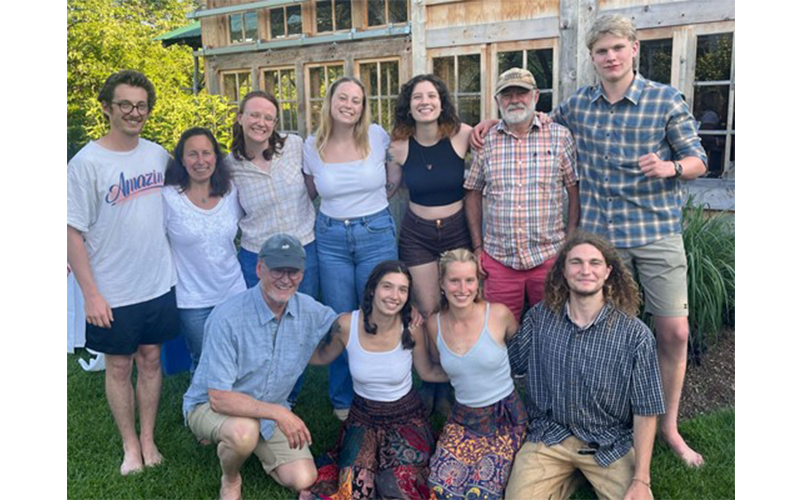By Ashley Cray, UVM knotweed project coordinator
This year eight interns from the Rubenstein School of Natural Resources and the Environment at the University of Vermont are continuing efforts in The Valley to remove Itadori knotweed, map infestation sites, and educate the community on invasive species. This year’s interns are Cray, Megan Anderson, Naomi Cocker, Jaylyn Davison, Nick Graceffa, Jack Locker, Rex Jacobsen, and Sophie Becker.
They are working on sites in Warren, Waitsfield, and Fayston. The interns split their time between the three towns.
In Warren, under the guidance of Jito Coleman, the interns are completing the first round of pulling and digging at the sites. This includes working on sites along Route 100 in the Granville Gulf, on Roxbury Gap, along Fuller Hill Road, Charlie Ashley Road, along Plunkton Road, and around Blueberry Lake for a total of more than 150 individual sites. Every week the interns join community volunteers for the Warren community volunteer days on Tuesdays from 4 to 6 p.m.
The work consists of pulling up knotweed stalks and rhizomes and placing them on drying racks which starves the rootstock of energy, weakens the plant, and leads to eventual death. The team worked on the smother site located in the Wabanaki Conservation Area. The site was uncovered halfway for the first time in two years. The interns and conservation commission will be monitoring new growth between the uncovered and covered half, to gauge effectiveness of this method. The uncovered portion was recovered with a used vinyl tarp that is intended to be more effective, cheaper, and longer lasting. Each year the site will be monitored to determine the effectiveness.
Additionally, interns have been mapping knotweed infestation sites using the new invasive mapping program iMapInvasives. They use the app to map where the infestations are and the strength of the infestation. By the end of the season, they intend to have new maps created on ArcGIS displaying this information. The interns have also been working alongside the U.S. Forest Service to map invasives on Forest Service land present in Warren.
WAITSFIELD
In Waitsfield, under the direction of conservation commission members Curt Lindberg and Bob Cook, the interns have worked to control knotweed infestations at the Lareau Swim Hole. They have been pulling regrowth, digging root crowns, and cutting back growth along the Mad River Path. Considerable effort has also been directed towards the Tardy property, where interns and volunteers on the weekly Knot Thursdays have been cutting back stems and digging up root crowns and rhizomes. Additionally, at the Tardy property, interns have begun taking an in-depth inventory of other invasive species present on the property. To date, invasives present include honeysuckle, buckthorn, reed canary grass, and Dame’s Rocket.
Interns have also put effort into controlling knotweed at Bridge Street in Waitsfield. This is another spot where interns have worked closely with volunteers at Knot Thursdays from 4 to 6 p.m. to pull regrowth, dig root balls, and share knowledge and experience with each other. Outside of community volunteer days, the interns have been spending time managing knotweed at other sites on East Warren Road, Sherman Road, and Center Fayston Road as well as mapping infestations. This year, the interns have begun tabling at the Waitsfield Farmers Market on selected Saturdays. They will be there July 29 and August 19.
FAYSTON
This is also the first year interns have been working with Henderson in Fayston. After moving from Massachusetts to Vermont, Andrea got involved with knotweed efforts in Waitsfield and then joined the Fayston Conservation Commission. She is now leading knotweed efforts in Fayston. Interns join community members on Wednesdays from 4 to 6 p.m. for community work days
Work in Fayston has been focused on infestations on German Flats Road, Mt. Ellen Road, Barton Road, the Chase Brook Town Forest Park, North Fayston Road, and Old Duxbury Road near the town’s gravel pit, as well as creating maps of infestations within Fayston.
In all three towns, interns and supervisors have created a data collection system to track progress on management of infestations. At selected sites, interns collected data regarding the number of knotweed shoots present, other plants present, percent biomass and the average diameter of the stems. This data was collected within a 9-square-foot plot and will be collected at the beginning of every June in order to track progress.
Interns have also been maintaining a strong social media presence on the Instagram account, @madriverknotweed. New this year is a Tiktok, @madknotweed, where interns make videos about their work in The Valley.
The group encourages volunteers to join them in Warren from 4 to 6 p.m. every Tuesday (contact













